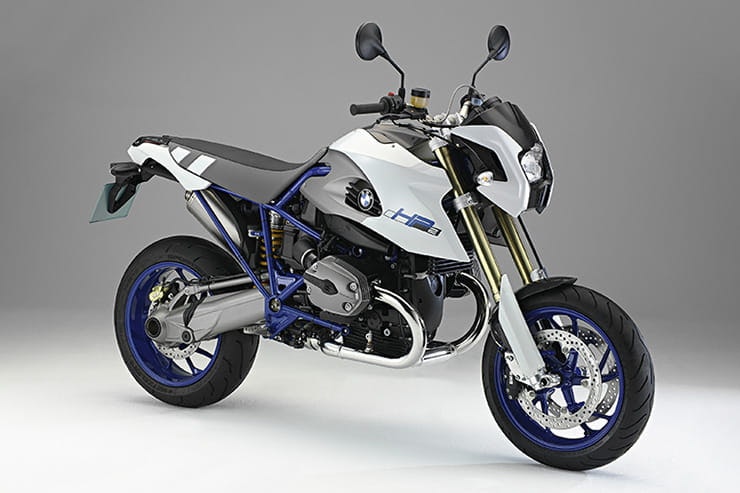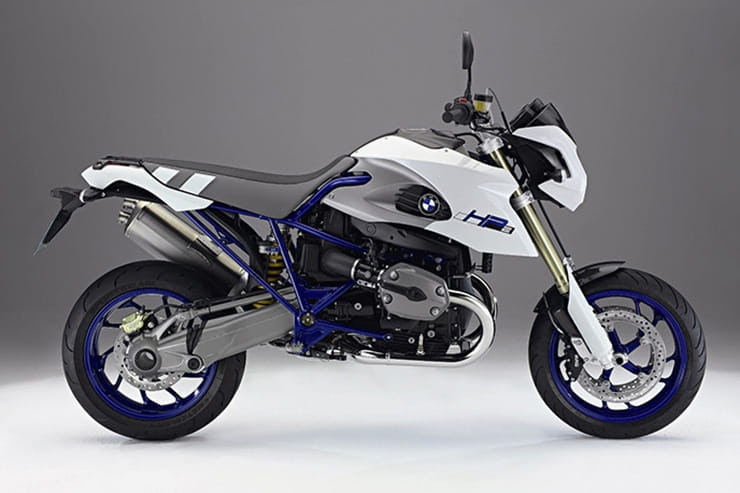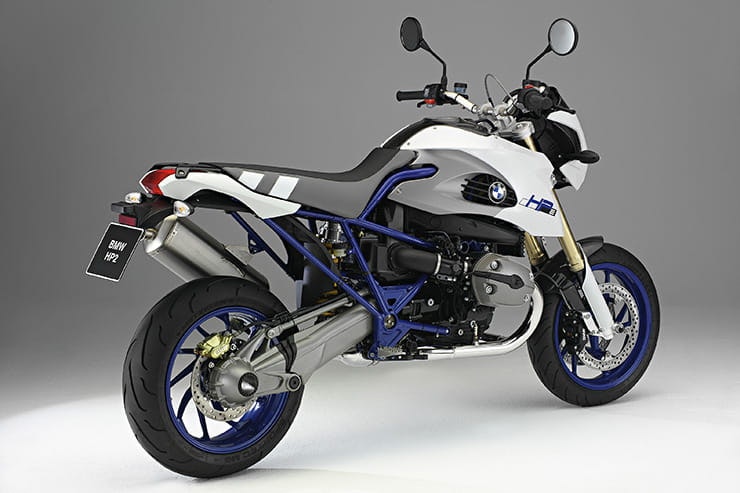BMW HP2 Megamoto (2007-2010): Review & Buying Guide
By Jon Urry
Massively experienced road tester
31.03.2022
The BMW HP2 Megamoto is one of those bikes that few riders will probably have ever heard of – and even fewer actually seen in the flesh. Launched in 2007, the Megamoto was the second of BMW’s boundary-pushing (and wallet-bashing) HP2 (High Performance two-cylinder) models and followed on from the hardcore HP2 Enduro. Where the Enduro was an off-roader, the Megamoto took its influence from supermotos and as such came with chunky forks, 17-inch wheels and sticky road tyres. A seriously premium product, not only was the Megamoto’s price tag high, so was its level of build quality – two things that instantly ensured exclusivity. Very few were sold in the UK and unlike its popular third sibling, the 2008 HP2 Sport, the Megamoto was fairly short lived. If you want a head-turner of a bike, the Megamoto is probably one of the rarest two-wheelers on the UK’s roads. However, this exclusivity comes at a high financial cost...
BMW HP2 Megamoto (2007-2010) Price
The Megamoto cost an eye-watering £12,595 in 2007 – which was a heck of a sting when you consider a GS was £9000 and came with far more in the way of creature comforts. As it failed to attract buyers, prices did drop, and bikes were changing hands for under £10,000 by the time it went off sale. However, that’s when things changed and like the HP2 Sport and Enduro, prices have now more than recovered. If you can find one, and they are rare, a Megamoto will cost you in the region of £15,000 for a good example. Although saying that, they are all generally good as very few were ridden that much...
Power and torque
Unlike the HP2 Sport, which was the first double overhead cam boxer motor, the Megamoto uses the older single overhead cam engine. Effectively a tweaked GS motor, the Megamoto makes 105bhp with 85lbft of torque, which is very slightly up on the 98bhp BMW claimed for the GS with the same torque figure. And quite a lot shy of the 130bhp the Sport made! Like all older boxer engines, the Megamoto has bags of instant punch and is a really spirited and exciting engine that sounds awesome – especially with the help of the fruity Akrapovič can that came as standard. A few riders feel the need to tweak the fuelling to smooth the throttle response a bit, however on a bike that looks like it has a stack of attitude such as the Megamoto, this raw nature is kind of in keeping with the machine and is best left alone.
Engine, gearbox and exhaust
As the Megamoto’s engine is so closely related to the GS’s there is little to fear. Service intervals are the standard boxer 6000 miles, valve clearances are nice and easy due to the exposed heads and reliability shouldn’t be a concern. Also, unlike the Sport, there is no need to strip the motor at 50,000 miles and measure everything!!! Most Megamotos for sale have less than 10,000 miles on their clocks so you are really checking that it has been cared for and serviced regularly more than inspecting for mechanical horrors. The double-chamber Akrapovič exhaust not only helps boost the bike’s power and give it a stunning exhaust note, it is also beautifully made, so rust isn’t a worry. Overall, if it starts, ticks over and has a good service history, you should be safe, and the worst case is a duff sensor. Unless the clutch is slipping, which is almost certainly won’t be, but check on a test ride!!!
BMW HP2 Megamoto (2007-2010) Economy
This isn’t much of an issue on a bike such as a Megamoto but if it worries you BMW claimed the Mega could average between 51 and 68mpg, which was fairly optimistic, and you are far more likely to see figures in the 40mpg area. As it only has a 13-litre tank, that equates to a range of about 120 miles.
Handling, suspension, chassis and weight
The Megamoto always had handling at the forefront of its design and BMW did a good job on this front. It may be a bit chunky at 199kg (which to be fair is light for a BMW but heavy for a supermoto...) but you get 17-inch wheels and a good suspension set-up that includes beefy 43mm Marzocchi forks and an Öhlins shock. Thanks to this set-up the Megamoto handles well and can certainly be enjoyed in the bends with enthusiasm. As standard the damping set-up is quite firm, which suits its sporting outlook, but a lot of owners take advantage of the suspension’s full adjustability to ease it off a touch. Something that can be more of an issue, however, is the seat height – which is a stratospheric 910mm on its highest setting and simply tall on its 860mm lowest! Shorter riders may find this a bit of a challenge... When buying used, much like the engine, there is little to worry about too much however always check the Öhlins shock for leaks as they don’t like to be left standing (they are fully rebuildable for about £250) and can start to leak. If this is happening, take the bike for a ride, then check it again as often it leaks a bit of oil then reseals. GS owners will say the rear hub bearing will start to fail at 40,000 miles but there is no way a Megamoto will be nearing this point. Have a good inspection of the bodywork for cracks around the fixing lugs (more of an issue on the Sport) but overall if it looks good it should be a sound buy.
BMW HP2 Megamoto (2007-2010) Brakes
BMW ensured the Megamoto would stop on demand and armed it with twin discs and four-piston brake calipers with braided lines where the Enduro only got a single disc. A good set-up, there is little to find fault with aside from the fact it lacks ABS, which wasn’t an option in the UK. Oddly, a few Megamotos from other European countries are advertised with ABS on them, an option which may have skipped the UK due to our limited number of sales.
Comfort over distance and touring
With a firm seat and very little in the way of wind protection, you don’t really want to be covering long distances on the Megamoto – not that you can anyway with the limited range offered by its 13-litre tank.... This is a short-hop bike for maximum fun and comfort takes a back seat. Well, it would do if there were any pillion provisions, but the Megamoto also lacks pillion pegs!
Rider aids and extra equipment / accessories
In terms of rider assists, there are none on the Megamoto and no add-on options for TC or ABS. BMW also didn’t offer much in the way of accessories for the Megamoto and it is very much a bike that buyers bought and left as BMW delivered it. The only aftermarket accessories you may see is a set of free-breathing headers and possibly a fuelling module. Which to be fair is all the bike requires.
BMW HP2 Megamoto (2007-2010) verdict
The BMW HP2 Megamoto is rare and therefore desirable - but it has to be said, it is also overpriced. Where the glorious HP2 Sport delivers on every level, the Megamoto is a bit more of a one-trick pony and while it is undeniably very cool, it is also pretty impractical and in reality, isn’t that trick. If you want to turn up on a bike that very few riders have ever seen it certainly ticks that box, but where you can drool over an HP2 Sport for ages, with the Megamoto your attention isn’t captured for quite as long.
Three things we love about the HP2 Megamoto…
Exclusivity
Build quality
Amazing exhaust note
Three things that we don’t…
Price – it keeps going up!
Hard to locate in the used market
It’s not that special in terms of tech
BMW HP2 Megamoto (2007-2010) spec
Looking for motorbike insurance? Get a quote for this bike with Bennetts motorcycle insurance


